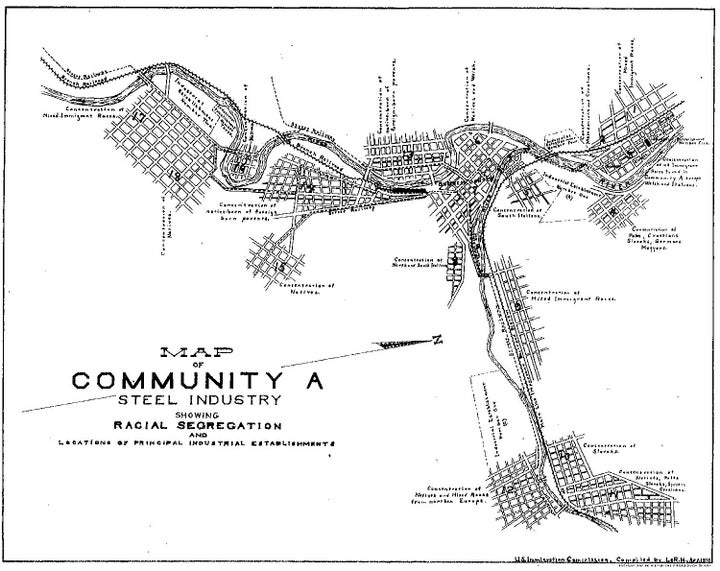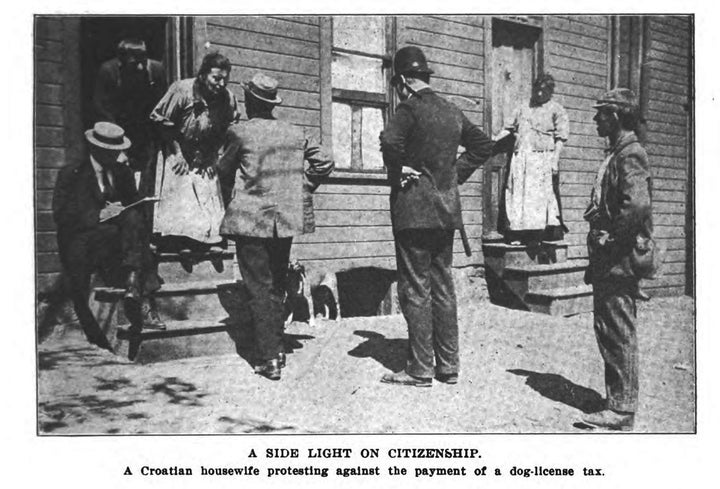
In August, retired doctor David S. Glosser publicly unloaded on his nephew Stephen Miller for Miller’s “hypocritical” stance on immigrants by telling their family’s coming-to-America story.
When the first Glosser arrived at Ellis Island in 1903, the United States had virtually no meaningful immigration restrictions beyond the infamous Chinese Exclusion Act of 1882. Only 2 percent of the immigrants who arrived at Ellis Island were turned away, and federal authorities did not even bother to count land-crossing migrants until 1908. As a result, nearly 15 percent of the U.S. population in 1910 was foreign-born ― a proportion never exceeded (although the country came close before the 2008 recession).
Chain migration quickly brought more Glossers to the United States, where they settled in the iron and steel city of Johnstown, Pennsylvania. The first Glossers’ peddler wagon evolved into the city’s second-largest department store, which employed hundreds ― including “almost every Jewish person,” according to one old-timer ― and became a chain of nearly three dozen stores across the region.
Historians love irony, and this story’s got it. First, the Glossers’ Johnstown ― now an unremarkable Rust Belt artifact — played a central, if unheralded, role in shaping modern immigration policy. In the early 20th century, it served as the prototype community — literally “Community A” — for a 20-volume set of reports on “Immigrants in Industry” that constituted half of the largest study of immigrants in American history. The study was produced by the U.S. Immigration Commission, a congressional special committee widely known as the Dillingham Commission. Its reports recommended immigration restrictions that would lead to the literacy test of 1917.
Second, Johnstown was chosen for this honor by another young federal employee eager to influence economic and immigration policy. But W. Jett Lauck was from West Virginia, not Santa Monica, California, and he was a nicer guy than Stephen Miller. And the Progressive Era, unlike our own, put high stock in empiricism. (The Dillingham Commission’s reports were full of objective facts, or so they claimed.)
So there is a grim historical neatness to the revelation that Miller’s ancestral origins can be traced to Johnstown. In many ways, it’s the birthplace of a national consensus on immigration that led to the openly racist quota laws of the 1920s. In 2015, these laws were praised by now-Attorney General Jeff Sessions, then a U.S. senator from Alabama, whose communications director at the time was Stephen Miller, grandson of Izzy Glosser, a scion of those first industrious Glossers.
“There is a grim historical neatness to the revelation that [Stephen] Miller’s ancestral origins can be traced to Johnstown ... the birthplace of a national consensus on immigration that led to the openly racist quota laws of the 1920s.”
The Glossers’ Johnstown epitomized the transformation of the American economy — and the American public — in the robber baron era. It was poor, crowded and “dirty with dust and soot,” in the words of one immigrant newcomer. Bethlehem Steel founder Charles Schwab described “the pall around Johnstown.” He wrote, “The murk was always present, the smell of the foundry. It gets into your hair, your clothes, even your blood.”
Johnstown was one of the first coal, iron and steel centers in the United States, and it was as divided by class and ethnicity as anywhere else in America. In 1889, a dam burst and flooded the town, killing 2,200 people. The reservoir that was unleashed on Johnstown was owned by a private rod-and-gun club whose members included Andrew Carnegie, Henry Clay Frick and Andrew Mellon. The larger region had a history wracked with labor conflict — most famously, the 1892 Homestead Strike against Carnegie Steel.
We know a lot about Johnstown, thanks to Volume 8 of the Dillingham Commission reports. The year after Miller’s forebears arrived in Johnstown, the federal government began its research there. The Dillingham Commission (named for its chair, Vermont Republican Sen. William P. Dillingham) lasted from 1907 to 1911. Half of its 41 volumes contained the “Immigrants in Industry” reports. The colossal undertaking covered the full breadth of American mining and manufacture: from producing agricultural implements to making gloves, from meat packing to rope, twine and hemp production. From Buffalo to Butte to Birmingham, federal employees counted workers of 93 different nationalities or “races.” They collected original data from nearly every major industry and from 1 in 7 members of the nation’s entire manufacturing and mining work force. The volume that included Johnstown contained “detailed information” on 11,908 individuals, including 4,693 women.
The city, which was dominated by the Cambria Steel corporation, saw its population increase by more than half between 1900 and 1910. Over half the iron- and steelworkers in the Johnstown region had been in the United States for less than five years, 80 percent for less than a decade. The Dillingham Commission reports detailed steel mill jobs that included “grade boys, test boys, ingot scalemen, clean-ups, car greasers, foremen, skull crackers and helpers, and cupola-drop men,” all working 12-hour shifts six days a week. Some people labored seven days.
Almost all of these workers were immigrants. It was the first industry and region in the country to employ Slavs in large numbers. Where the Irish and Welsh had once predominated, by the early 20th century Magyars, Poles, Slovaks, Lithuanians, Italians, Russians, Croatians, Bohemians, Scandinavians, Greeks, Ruthenians and Serbians were everywhere. The Slavs, known derisively as “Hunkies,” received particular attention and opposition.

Lauck, director of the industrial reports, was a newly married and well-connected 28-year-old. Like Miller today, he looked around and saw a country in transition, filling with immigrants and adapting fitfully to a new, lower-wage economy.
In the years since, the Dillingham Commission has come under some harsh criticism — much of it deserved, some of it exaggerated (“Forty-one volumes, all of it garbage,” wrote The New York Times). Yet it is worth noting that Lauck, unlike Miller, was harder in some ways on “Americans” than he was on the immigrants. The Johnstown report concluded that the “general” attitude of Americans to new immigrants was “at best, aloofness and indifference.”
“The native population knows practically nothing about these immigrants beyond what they read in the daily newspapers about crimes, etc., committed on the foreign section” and what “little contact they have with … servants, washerwomen, etc.,” the report said. The new immigrants “suffer from a constant attitude of contempt toward them.” The report noted that business taxes were regressive, penalizing small enterprises, and new immigrants who became citizens, like black people in the Jim Crow South, were dissuaded from voting by poll taxes.
Lauck recommended lowering the number of immigrants into the United States. But he did not think that new immigrants were inherently inferior or that assimilation was impossible. He argued that temporary limits on immigration were necessary only so that the current population could be “absorbed and elevated” to “demand proper wages and working conditions.”
“Persons who have had little data at their possession” have blamed new immigrants for “crime, vice, insanity, or pauperism,” he complained. But the Dillingham Commission’s exhaustive studies, he wrote, “do not justify these contentions.” Then as now, crime among new immigrants was no higher than among other groups. Lauck even pointed out that “existing exclusion laws effectively kept out criminals and other ‘undesirables.’”
Both Lauck and Miller were once untested men with big ideas about immigration. Both advocated policies that hurt immigrants — Lauck with good intentions, Miller with evident malice. The former’s careful work in Johnstown helped create the boogeyman that the latter would exploit more than a century later.
But Lauck would emerge from the Dillingham Commission a changed man. He went on to wage a war not against immigrants but for a living wage for all workers. He left a scrap of paper in his personal files on which he had jotted “‘Code’: Love-Faith-Truth-Hope.” It seems unlikely that Miller will ever do that.
Lauck’s beef was really with capitalists: The presence of new immigrants made it too easy for robber barons to continue to rob, and the federal government had not yet countenanced a federal minimum wage, much less broad worker safety regulations. For Lauck, this was one lesson he learned in Johnstown: Real monsters were on the loose in America, and they weren’t the immigrants.
Katherine Benton-Cohen is the author of Inventing the Immigration Problem: The Dillingham Commission and Its Legacy.